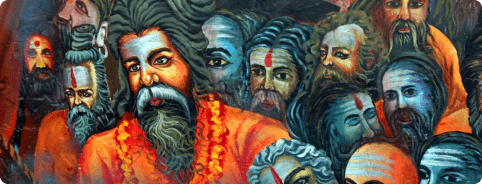The origin of Maha Kumbh Mela was transcribed by the 8th-century philosopher Adi Shankaracharya. The founding myth of the Kumbh Mela points out to the Puranas (compilations of ancient legends). It recounts how Gods and demons fought over the sacred pitcher (Kumbh) of Amrit (nectar of immortality) called the Ratna of Samudra Manthan. It is widely believed that Lord Vishnu (disguised as the enchantress ‘Mohini’) whisked the Kumbh out of the grasp of the covetous demons who had tried to claim it.

As he took it heavenwards, a few drops of the precious nectar fell on the four sacred sites we know as Haridwar, Ujjain, Nashik and Prayagraj. The flight and the following pursuit is said to have lasted twelve divine days, which is equivalent to twelve human years and therefore, the Maha Mela is celebrated every twelve years, staggered at each of the four sacred sites in this cycle. The corresponding rivers are believed to have turned into Amrit at the cosmic moment, giving pilgrims the chance to bathe in the essence of purity, auspiciousness, and immortality.
Maha Kumbh is one of the most sacred pilgrimage events for Hindus. It became a matter of research amongst scholars when the legend of Kumbh began attracting millions of pilgrims from across the world. However, it is an established fact that Prayag has been the center stage of Kumbh, and an event of such grand scale does not culminate in one day but gradually develops over a period of time.
The term ‘Kumbh’ comes from the root ‘kumbhak’ (the sacred pitcher of elixir of immortality). There is a mention of ‘Kumbh’ and the bathing ritual associated with it in the Rig Veda (verse 10.89.7). It speaks of the benefits of bathing at sangam during this period, elimination of negative influences and rejuvenation of mind and soul. Prayers for the ‘Kumbh’ are also expressed in Atharva Veda and Yajur Veda.
Historic evidence points towards the rule of King Harshvardhana (c.590-647 AD), as the time when Kumbh Mela got widespread recognition across geographies. Famous traveler Hsuan Tsang has prominently mentioned the grandeur of Kumbh Mela in his travelogue. The traveler’s account also summarizes King Harsh’s charities at the confluence of holy rivers where he gave gifts and donations to the scholars and sanyasis. King Harsh used to hold a great quinquennial assembly on the sands of the holy confluence at Prayag and would distribute all his possessions.
Moreover, the historical texts also point towards evidence that Adi Shankaracharya established 10 Akharas, Ardha Kumbh and Kumbh Mela.
The Kumbh Mela at Prayag is widely considered as the most significant among all the Kumbh festivals held at other locations. It is considered as the source of light and knowledge. It is believed that Prajapati Bramha performed Ashvamedha Yajna at Dashashvamedha Ghat situated at the confluence of the Ganga and Yamuna and created the universe due to which it is the most famous and significant among all other Kumbh festivals.
Elemental meaning of Kumbh is:
- The confluence (Sangam) of all the cultures in the universe
- A spiritual conscience
- The flow of humanity
- The flow of rivers, forests, and Rishi culture
- The flow of life
- The communion of nature and human life
- The source of energy
- The path of enlightenment


